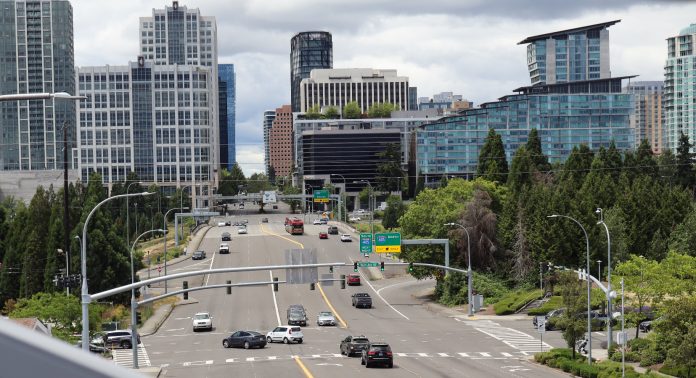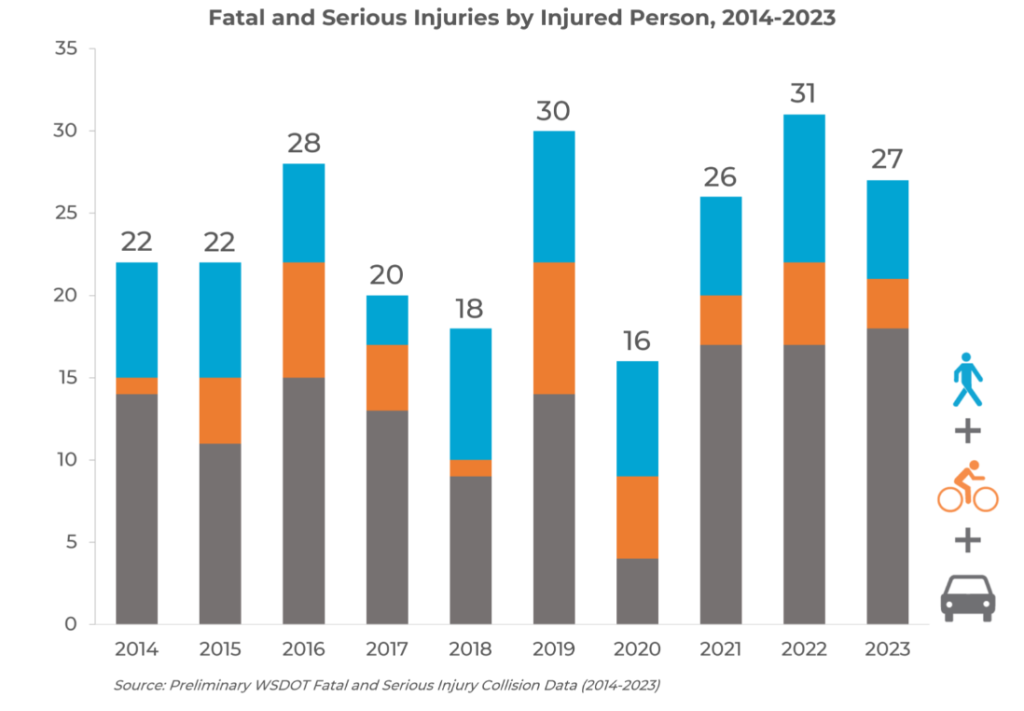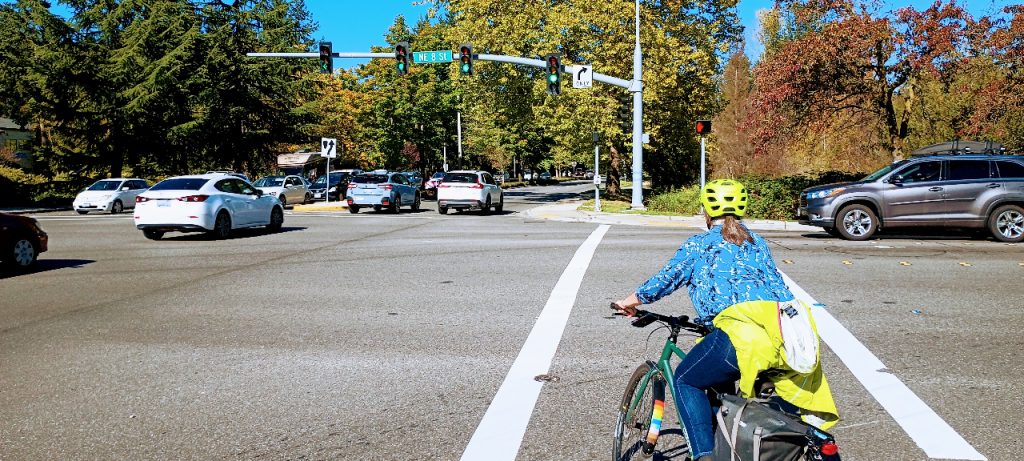
Over recent years, infamously car-dominated Bellevue had been making significant progress toward making it easier to get around without a car, but that progress has mostly stalled out. One big blow was the recent gutting of the ambitious Bike Bellevue plan, which was envisioned as a quick-build network to right-size some of Bellevue’s most dangerous streets, while at the same time carving out space for people to bike. In their deliberations, the Bellevue City Council made it clear that they don’t support reallocating existing vehicle lanes except as an absolute last resort.
Now a group of advocacy organizations, including Complete Streets Bellevue, 350 Eastside, Eastside Urbanism, Livable Kirkland, and Move Redmond, are pushing the city to get things back on track. They are targeting Bellevue’s next biennial budget, which is officially in early deliberations phase after a public hearing this week.
The coalition wrote to the council this week, asking for Vision Zero funding to be ramped up and targeted toward improvements that can be implemented quickly to meet the City’s goal of eliminating traffic deaths and serious injuries by 2030. Bellevue adopted its “Vision Zero” goal in 2015 — the same year as Seattle affirmed its own Vision Zero pledge. Neither city is on course to meet their pledge.
“Through ongoing work to lower speeds on neighborhood & arterial streets, deployment of tactical infrastructure, and using technological innovation, Bellevue is a leader in traffic safety in Washington state. However, 27 people were still seriously injured or killed on city streets in 2023,” the letter noted.
“Our city staff has done excellent work for multiple years to study, design, and plan for facilities that can be built rapidly to both meet Bellevue’s local mobility challenges, and address crucial safety needs on the city’s busiest streets,” Christopher Randels, director of Complete Streets Bellevue, told the council Tuesday. “It’s this work that has shown us that 80% of the fatal and serious injury collisions happen on just 8% of Bellevue’s streets.”
While injuries on Bellevue’s streets do happen at a lower rate than other nearby cities, including Seattle, the trend line has not been headed in the right direction.

Just a few days after the public hearing on the budget, Bellevue’s transportation commission officially voted to water down three of the most important corridor projects that Bike Bellevue had planned to tackle. Both NE Bel-Red Road and 140th Avenue NE, critical east-west and north-south connections, will see no changes anytime soon. Northup Way will see lane narrowing to create space for bike lane buffers along a short segment, but along most of the street space for people biking will only happen as properties redevelop, a process that will take years and not impact the existing oversized roadway.
Those cuts happened after the commission already voted to scale back a planned separated bike route along NE 2nd Street in Downtown Bellevue to shared lane markings.
“We are concerned with recent planning efforts, such as the current state of the Bike Bellevue program, which have pivoted improvements originally slated for rapid implementation towards longer-term investments,” the coalition’s letter noted. “Every year of delay in the implementation of pedestrian, bicycle, and transit facilities represents a tangible risk that another person is going to be seriously injured or killed on Bellevue streets.”
Numerous speakers Tuesday night told the council how their quality of life as Bellevue residents or visitors would be improved by better bike connections, especially to newly opened light rail stations or Eastrail, a regional multi-use trail in the process of expanding in Bellevue to close a key gap in the 42-mile corridor.
“Owning a bike has completely changed the way I see Bellevue. It’s allowed me to slow down, take in the city’s details and discover parts of the city that I never have stumbled upon otherwise,” recent high school graduate Jonah Cole told the council. “But biking has also invested my safety in your policy. That’s why I’m here today to urge you to protect vulnerable road users like myself, and many others, not just to save lives, but to encourage more Bellevue residents to get out there and walk, bike or roll.”

In addition to prioritizing spending existing revenue on projects that can be built right away, the council was urged to look at additional revenue sources to accelerate Vision Zero projects across the city. One untapped revenue source that advocates want to see Bellevue utilize is a sales tax increase authorized under state law for transportation improvements. Last year, Bellevue took steps to establish the transportation benefit district required to levy the tax, but hasn’t yet voted to start collecting any revenue. Many other nearby cities, including Redmond, have tapped into this funding source, but so far Bellevue has not. If approved, it would be expected to bring in around $10 million per year.
The coalition also wants the City to reprioritize how it spends funding from the 2016 Neighborhood Safety, Connectivity and Congestion levy. A 20-year levy originally approved to pay for both neighborhood traffic safety and road-widening projects, Bellevue has generally allocated $2 million per year to so-called congestion relief projects. “Given the severity of the need for pedestrian, bicycle, and safety funding, these funds could be better allocated towards tactical safety improvements,” the coalition’s letter noted.
Unlike many cities around the region, Bellevue isn’t facing a looming budget deficit in the coming years, but it’s also not expecting to be flush with new revenue. “The punchline is, the city is in a relatively stable position going into this budget proposal,” Bellevue’s interim City Manager Diane Carlson told the council this week. “The cautious note is that it’s not a growth budget.”
“This is going to be a tough year of having that fiscal discipline, as well as really thinking about how are we positioning for the future: how do we make those smart, strategic investments even in a year where our revenues are flat,” Councilmember Janice Zahn said. But Zahn specifically mentioned funding for Vision Zero as one area where the council would likely focus its attention. That call was echoed by Mayor Lynne Robinson, who cited “rapid implementation” of Vision Zero infrastructure as one of her priorities.
Councilmember Jared Nieuwenhuis, on the other hand, argued that the city needed to weigh urgent needs like Vision Zero against budget realities, pushing back against the idea of raising additional funding.
“I would very much urge caution,” Nieuwenhuis said. “I know there are a few levers that we could pull in terms of generating additional revenue, that were mentioned tonight and [are] things that we’ve flirted with in the past, but I would urge caution on that because there are a lot of folks that can barely hang onto their homes right now.”
On the other hand, making it more feasible and safe for Bellevue residents to get around without a car would allow them to cut their transportation expenses, providing a significant benefit. Any potential tax increases should be looked at through a wider lens than what Nieuwenhuis appeared to suggest.
The next public hearing on the budget is scheduled for September, after a draft budget is submitted to the council by Bellevue’s city manager. Then deliberations will start in earnest, with final adoption of the budget just before Thanksgiving. It’s clear that even with the council’s gutting of the Bike Bellevue plan, the issue of improving safety and mobility on Bellevue’s streets isn’t going away anytime soon.
Ryan Packer has been writing for The Urbanist since 2015, and currently reports full-time as Contributing Editor. Their beats are transportation, land use, public space, traffic safety, and obscure community meetings. Packer has also reported for other regional outlets including BikePortland, Seattle Met, and PubliCola. They live in the Capitol Hill neighborhood of Seattle.

